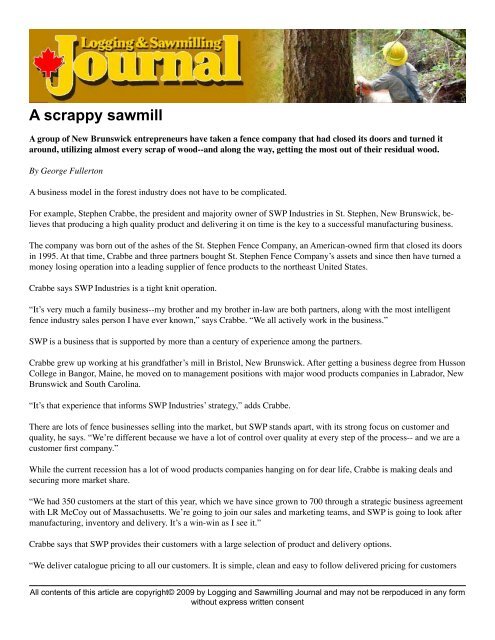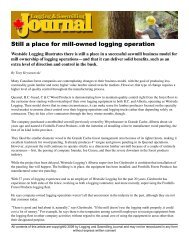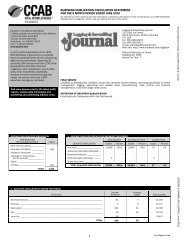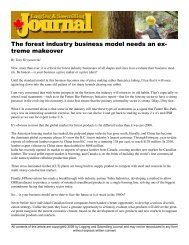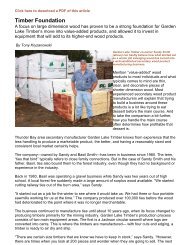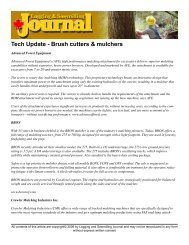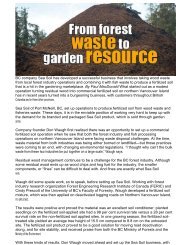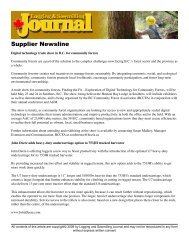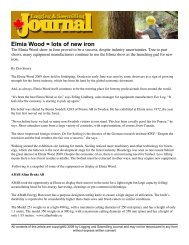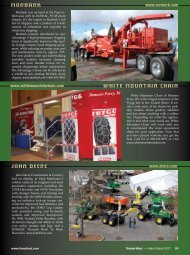A scrappy sawmill - Logging and Sawmilling Journal
A scrappy sawmill - Logging and Sawmilling Journal
A scrappy sawmill - Logging and Sawmilling Journal
You also want an ePaper? Increase the reach of your titles
YUMPU automatically turns print PDFs into web optimized ePapers that Google loves.
A <strong>scrappy</strong> <strong>sawmill</strong><br />
A group of New Brunswick entrepreneurs have taken a fence company that had closed its doors <strong>and</strong> turned it<br />
around, utilizing almost every scrap of wood--<strong>and</strong> along the way, getting the most out of their residual wood.<br />
By George Fullerton<br />
A business model in the forest industry does not have to be complicated.<br />
For example, Stephen Crabbe, the president <strong>and</strong> majority owner of SWP Industries in St. Stephen, New Brunswick, believes<br />
that producing a high quality product <strong>and</strong> delivering it on time is the key to a successful manufacturing business.<br />
The company was born out of the ashes of the St. Stephen Fence Company, an American-owned firm that closed its doors<br />
in 1995. At that time, Crabbe <strong>and</strong> three partners bought St. Stephen Fence Company’s assets <strong>and</strong> since then have turned a<br />
money losing operation into a leading supplier of fence products to the northeast United States.<br />
Crabbe says SWP Industries is a tight knit operation.<br />
“It’s very much a family business--my brother <strong>and</strong> my brother in-law are both partners, along with the most intelligent<br />
fence industry sales person I have ever known,” says Crabbe. “We all actively work in the business.”<br />
SWP is a business that is supported by more than a century of experience among the partners.<br />
Crabbe grew up working at his gr<strong>and</strong>father’s mill in Bristol, New Brunswick. After getting a business degree from Husson<br />
College in Bangor, Maine, he moved on to management positions with major wood products companies in Labrador, New<br />
Brunswick <strong>and</strong> South Carolina.<br />
“It’s that experience that informs SWP Industries’ strategy,” adds Crabbe.<br />
There are lots of fence businesses selling into the market, but SWP st<strong>and</strong>s apart, with its strong focus on customer <strong>and</strong><br />
quality, he says. “We’re different because we have a lot of control over quality at every step of the process-- <strong>and</strong> we are a<br />
customer first company.”<br />
While the current recession has a lot of wood products companies hanging on for dear life, Crabbe is making deals <strong>and</strong><br />
securing more market share.<br />
“We had 350 customers at the start of this year, which we have since grown to 700 through a strategic business agreement<br />
with LR McCoy out of Massachusetts. We’re going to join our sales <strong>and</strong> marketing teams, <strong>and</strong> SWP is going to look after<br />
manufacturing, inventory <strong>and</strong> delivery. It’s a win-win as I see it.”<br />
Crabbe says that SWP provides their customers with a large selection of product <strong>and</strong> delivery options.<br />
“We deliver catalogue pricing to all our customers. It is simple, clean <strong>and</strong> easy to follow delivered pricing for customers<br />
All contents of this article are copyright© 2009 by <strong>Logging</strong> <strong>and</strong> <strong>Sawmilling</strong> <strong>Journal</strong> <strong>and</strong> may not be rerpoduced in any form<br />
without express written consent
etween here <strong>and</strong> Baltimore. Our customers have the freedom of dealing with a salesman, or our order desk direct.”<br />
Crabbe says SWP’s website has engineered drawings <strong>and</strong> specifications of all of the company’s products, including cedar<br />
fence panels, as well as vinyl <strong>and</strong> aluminium.<br />
“Homeowners, especially in the northeast U.S., consider a fenced yard a key part of the American homeowner’s dream.<br />
You can make a fence out of a lot of different materials, but a natural cedar panel fence is still the market leader,” explained<br />
Crabbe.<br />
In addition to the manufacturing plant at St. Stephen a couple of minutes from the U.S. border crossing, SWP also operates<br />
two <strong>sawmill</strong>s, one at Bayside in southwest New Brunswick, <strong>and</strong> another at Arthurette in northwest New Brunswick.<br />
Crabbe points out that because the mills are spread out, yet close to the Maine border, they are strategically situated to<br />
extend SWP’s potential wood basket.<br />
“Our wood supply is second growth northern (eastern) white cedar. Half of our wood supply is out of Maine, the other<br />
half comes from private woodlots <strong>and</strong> Crown l<strong>and</strong> in New Brunswick,” he explains.<br />
The processing in both <strong>sawmill</strong>s starts with logs going through Morbark 531 Rosser debarkers <strong>and</strong> then feeding into PHL<br />
<strong>and</strong> Keystone twin-saws.<br />
At the Arthurette mill, the wood feeds into a Cardinal circular resaw. At Bayside, a Mainl<strong>and</strong> circular resaw <strong>and</strong> a Yates<br />
b<strong>and</strong> saw are used. Both mills use Valley 3-10 trim-saws.<br />
Mobile equipment at both <strong>sawmill</strong>s consists of Volvo L110 loaders to h<strong>and</strong>le roundwood <strong>and</strong> Volvo L50’s for moving<br />
bundles. SWP has three transport trucks, a Peterbilt, Kenworth, <strong>and</strong> Western Star. The company also has two leased units<br />
for multi-drop deliveries.<br />
Since 1999, SWP’s headquarters <strong>and</strong> manufacturing facility has occupied a 120,000 square foot building in the St. Stephen,<br />
New Brunswick, business park. The building provides space for inside lumber storage <strong>and</strong> several production lines.<br />
A 60,000 board-foot Nyle dehumidifying kiln dries lumber for finger-jointing, paneling <strong>and</strong> engineered lamp-posts. The<br />
finger jointing equipment is made by Grecon. The value-add plant in St. Stephen has two moulders, a Weinig <strong>and</strong> a Waco<br />
line.<br />
Crabbe says a lot of the equipment in the plant--like transfer tables <strong>and</strong> machines to make lattice--have been designed <strong>and</strong><br />
constructed in-house.<br />
“We want to scratch as much value as we can out of every log <strong>and</strong> every piece of lumber that we h<strong>and</strong>le,” explained<br />
Crabbe. “When most fence manufactures look at six-foot fence panels, they think six-foot lumber. We look at six-foot<br />
fence panels <strong>and</strong> come up with ways to make them out of four-foot <strong>and</strong> two-foot pieces of lumber as well.”<br />
Crabbe says getting the most value out of every board means finding profitable ways to deal with low-grade lumber.<br />
All contents of this article are copyright© 2009 by <strong>Logging</strong> <strong>and</strong> <strong>Sawmilling</strong> <strong>Journal</strong> <strong>and</strong> may not be rerpoduced in any form<br />
without express written consent
“We’ve developed a one-way cedar pallet made out of our low-grade materials. We sell a lot to the aquaculture industry-they<br />
like it because a lot of their product only ships one-way, <strong>and</strong> these pallets are cheaper <strong>and</strong> lighter. So our pallets can<br />
save money for those companies.”<br />
Sill, Crabbe says all their efforts would be for naught without good people working in the plant.<br />
“Our workforce is absolutely key to our success,” he emphasizes. “I’ve worked all over North America, <strong>and</strong> our workers<br />
in Charlotte County are as good as I’ve seen. We pay above average wages <strong>and</strong> we get above average performance from<br />
our people.”<br />
That said, like most every business struggling with the economic downturn, Crabbe says that their major challenge is<br />
securing financing.<br />
“Right now, the banks aren’t making things very easy for us.”<br />
All contents of this article are copyright© 2009 by <strong>Logging</strong> <strong>and</strong> <strong>Sawmilling</strong> <strong>Journal</strong> <strong>and</strong> may not be rerpoduced in any form<br />
without express written consent


